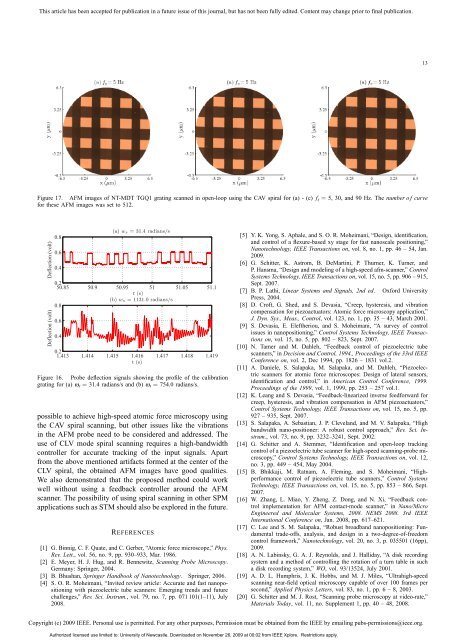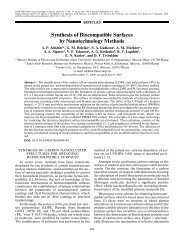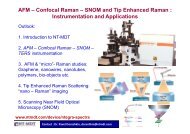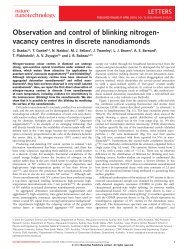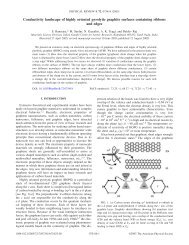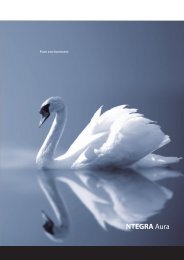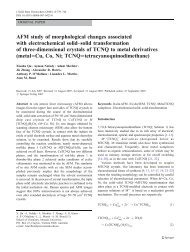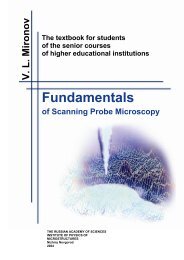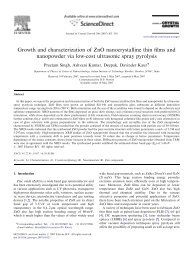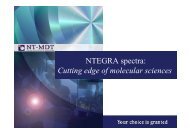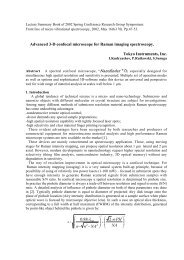A New Scanning Method for Fast Atomic Force Microscopy - NT-MDT
A New Scanning Method for Fast Atomic Force Microscopy - NT-MDT
A New Scanning Method for Fast Atomic Force Microscopy - NT-MDT
Create successful ePaper yourself
Turn your PDF publications into a flip-book with our unique Google optimized e-Paper software.
This article has been accepted <strong>for</strong> publication in a future issue of this journal, but has not been fully edited. Content may change prior to final publication.13Figure 17. AFM images of <strong>NT</strong>-<strong>MDT</strong> TGQ1 grating scanned in open-loop using the CAV spiral <strong>for</strong> (a) - (c) f s = 5, 30, and 90 Hz. The number o f curve<strong>for</strong> these AFM images was set to 512.Deflection (volt)Deflection (volt)0.80.60.40.250.85 50.9 50.95 51 51.05 51.1t (s)(b) w s = 1131.0 radians/s0.80.60.4(a) w s = 31.4 radians/s0.21.413 1.414 1.415 1.416 1.417 1.418 1.419t (s)Figure 16. Probe deflection signals showing the profile of the calibrationgrating <strong>for</strong> (a) ω s = 31.4 radians/s and (b) ω s = 754.0 radians/s.possible to achieve high-speed atomic <strong>for</strong>ce microscopy usingthe CAV spiral scanning, but other issues like the vibrationsin the AFM probe need to be considered and addressed. Theuse of CLV mode spiral scanning requires a high-bandwidthcontroller <strong>for</strong> accurate tracking of the input signals. Apartfrom the above mentioned artifacts <strong>for</strong>med at the center of theCLV spiral, the obtained AFM images have good qualities.We also demonstrated that the proposed method could workwell without using a feedback controller around the AFMscanner. The possibility of using spiral scanning in other SPMapplications such as STM should also be explored in the future.REFERENCES[1] G. Binnig, C. F. Quate, and C. Gerber, “<strong>Atomic</strong> <strong>for</strong>ce microscope,” Phys.Rev. Lett., vol. 56, no. 9, pp. 930–933, Mar. 1986.[2] E. Meyer, H. J. Hug, and R. Bennewitz, <strong>Scanning</strong> Probe <strong>Microscopy</strong>.Germany: Springer, 2004.[3] B. Bhushan, Springer Handbook of Nanotechnology. Springer, 2006.[4] S. O. R. Moheimani, “Invited review article: Accurate and fast nanopositioningwith piezoelectric tube scanners: Emerging trends and futurechallenges,” Rev. Sci. Instrum., vol. 79, no. 7, pp. 071 101(1–11), July2008.[5] Y. K. Yong, S. Aphale, and S. O. R. Moheimani, “Design, identification,and control of a flexure-based xy stage <strong>for</strong> fast nanoscale positioning,”Nanotechnology, IEEE Transactions on, vol. 8, no. 1, pp. 46 – 54, Jan.2009.[6] G. Schitter, K. Astrom, B. DeMartini, P. Thurner, K. Turner, andP. Hansma, “Design and modeling of a high-speed afm-scanner,” ControlSystems Technology, IEEE Transactions on, vol. 15, no. 5, pp. 906 – 915,Sept. 2007.[7] B. P. Lathi, Linear Systems and Signals, 2nd ed. Ox<strong>for</strong>d UniversityPress, 2004.[8] D. Croft, G. Shed, and S. Devasia, “Creep, hysteresis, and vibrationcompensation <strong>for</strong> piezoactuators: <strong>Atomic</strong> <strong>for</strong>ce microscopy application,”J. Dyn. Sys., Meas., Control, vol. 123, no. 1, pp. 35 – 43, March 2001.[9] S. Devasia, E. Eleftheriou, and S. Moheimani, “A survey of controlissues in nanopositioning,” Control Systems Technology, IEEE Transactionson, vol. 15, no. 5, pp. 802 – 823, Sept. 2007.[10] N. Tamer and M. Dahleh, “Feedback control of piezoelectric tubescanners,” in Decision and Control, 1994., Proceedings of the 33rd IEEEConference on, vol. 2, Dec 1994, pp. 1826 – 1831 vol.2.[11] A. Daniele, S. Salapaka, M. Salapaka, and M. Dahleh, “Piezoelectricscanners <strong>for</strong> atomic <strong>for</strong>ce microscopes: Design of lateral sensors,identification and control,” in American Control Conference, 1999.Proceedings of the 1999, vol. 1, 1999, pp. 253 – 257 vol.1.[12] K. Leang and S. Devasia, “Feedback-linearized inverse feed<strong>for</strong>ward <strong>for</strong>creep, hysteresis, and vibration compensation in AFM piezoactuators,”Control Systems Technology, IEEE Transactions on, vol. 15, no. 5, pp.927 – 935, Sept. 2007.[13] S. Salapaka, A. Sebastian, J. P. Cleveland, and M. V. Salapaka, “Highbandwidth nano-positioner: A robust control approach,” Rev. Sci. Instrum.,vol. 73, no. 9, pp. 3232–3241, Sept. 2002.[14] G. Schitter and A. Stemmer, “Identification and open-loop trackingcontrol of a piezoelectric tube scanner <strong>for</strong> high-speed scanning-probe microscopy,”Control Systems Technology, IEEE Transactions on, vol. 12,no. 3, pp. 449 – 454, May 2004.[15] B. Bhikkaji, M. Ratnam, A. Fleming, and S. Moheimani, “Highper<strong>for</strong>mancecontrol of piezoelectric tube scanners,” Control SystemsTechnology, IEEE Transactions on, vol. 15, no. 5, pp. 853 – 866, Sept.2007.[16] W. Zhang, L. Miao, Y. Zheng, Z. Dong, and N. Xi, “Feedback controlimplementation <strong>for</strong> AFM contact-mode scanner,” in Nano/MicroEngineered and Molecular Systems, 2008. NEMS 2008. 3rd IEEEInternational Conference on, Jan. 2008, pp. 617–621.[17] C. Lee and S. M. Salapaka, “Robust broadband nanopositioning: Fundamentaltrade-offs, analysis, and design in a two-degree-of-freedomcontrol framework,” Nanotechnology, vol. 20, no. 3, p. 035501 (16pp),2009.[18] A. N. Labinsky, G. A. J. Reynolds, and J. Halliday, “A disk recordingsystem and a method of controlling the rotation of a turn table in sucha disk recording system,” WO, vol. 93/13524, July 2001.[19] A. D. L. Humphris, J. K. Hobbs, and M. J. Miles, “Ultrahigh-speedscanning near-field optical microscopy capable of over 100 frames persecond,” Applied Physics Letters, vol. 83, no. 1, pp. 6 – 8, 2003.[20] G. Schitter and M. J. Rost, “<strong>Scanning</strong> probe microscopy at video-rate,”Materials Today, vol. 11, no. Supplement 1, pp. 40 – 48, 2008.Copyright (c) 2009 IEEE. Personal use is permitted. For any other purposes, Permission must be obtained from the IEEE by emailing pubs-permissions@ieee.org.Authorized licensed use limited to: University of <strong>New</strong>castle. Downloaded on November 26, 2009 at 00:02 from IEEE Xplore. Restrictions apply.


